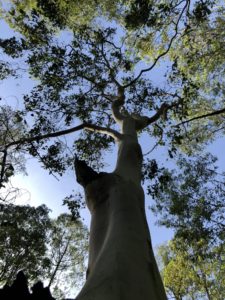Hi Everyone,
This weeks article details a meditation that I teach quite often in my Qi Gong meditation classes; meditating upon and breathing with the core of your body. It is a simple but profound way of learning how to positively connect and direct your subtle energies.
Toby

Article of the Week:
Meditating on Your Body’s Core
Awareness and meditation upon the core of the body is a practice that you find in Qi gong, Indian yoga and Tibetan yoga practices, all in slightly different forms. This article outlines a simple practice that I sometimes teach as an aspect of my Qi gong meditation classes.
What is your body’s core?
The core of the body (in the context of this article) is its “dead centre” so to speak. In terms of the head, neck, chest, abdomen and hips you could say that the core of these parts of the body is a line of energy running from the top of the centre of the head down through the centre of the brain, neck, chest, abdomen and hips, terminating at the perineum, the point between the middle of the legs. In particular for the purposes of this article we shall be focusing on the core of the body that runs from the lower abdomen up to about the level of the collar bone.
Why should you be interested in developing awareness of the core of your body?
Three main reasons:
1. If you check the way in which your body feels whenever you feel out of balance, physically, mentally and emotionally one thing that you will note is a feeling of being out of touch energetically with the central areas of the body, the heart and the abdomen in particular. It feels as if there are energies in these areas of the body that are dictating your experience. The core body meditation offers a technique for being able to “take back” control of these areas of the body energetically speaking, and thus gain greater volitional control of how you think and feel when under stress.
2. In general meditating on the core of the body enables us to develop the skill of moving energy from the core of the body to the surface of the skin and then back again to the core in a gentle, flowing movement that enables us to rapidly re-balance the qi or prajna within our subtle body, and release any energy blockages that there might be there.
3. Speaking a little more esoterically, the spiritual energies of our being are said to run inside a ‘central energy channel’ along the core of the body, from the top of the crown to the perineum. By meditating upon the core of our body we develop the ability to move our awareness into this subtle energy channel, which in turn enables us to develop deep spiritual states of awareness more readily and easily, though of course it takes regular practice!
Meditating on the core of your body
The nice thing about this meditation and breathing form is that it can be done either as a very short 1-5 minute meditation, or extended out to 20-40 minutes, or whatever time you have available. You simply divide your meditation time between the three steps below
Stage 1: Finding the core of your body
Sit in meditation with your hips, abdomen, chest, neck and shoulders aligned in a comfortable straight line. Visualize a line of light and energy going from the crown of your head down through the dead centre of your torso, ending at the perineum, the point between the middle of the legs. The line of light can be visualized as being about 1-2cm in diameter.
Rock your body gently from right to left to get a sense of this line of light being exactly in the middle of the right and left halves of your body. Then rock your body gently forward and back to get a sense of the line of light being exactly in the middle between the front and back halves of your torso.
You can either focus on the core of the body all the way from crown to perineum, or you can shorten your point of focus so that it includes the core from the level of the lower abdomen up to the collar bone.
Stage 2: Core body breathing
As you breathe in, feel the subtle energy (qi) of your whole body flowing from the surface (ie: the skin) into the central core of the body. As you breathe out feel and visualize the qi flowing from the surface of your body into the core. Do this in a focused, gentle manner for a few minutes.
(If it feels more natural, you can reverse this breathing technique, meaning as you breathe in you visualize the energy flowing from the core of your body to the surface, and as you breathe out it goes from the surface to the core, this is a matter of personal preference).
Stage three, focusing your energy within the core of your body.
Now either at the level of your heart (middle dan tien),or your lower navel (lower dan tien) see a point of particularly bright light within that section of your body’s core. Allow your awareness to absorb and rest within this point of light within the core of your body, letting go of conceptuality and mental activity as much as possible. Remain in this state of letting go for as long as you wish.
Awareness of the core of your body in daily life.
Once you are familiar with the basic aspects of the core body meditation form, you can use the core of the body, and core body breathing as a way of centering yourself wherever you are at any time.
© Toby Ouvry 2011, you are welcome to use or share this article, but please cite Toby as the source and include reference to his website www.tobyouvry.com

 Dear Integral Meditators,
Dear Integral Meditators,
